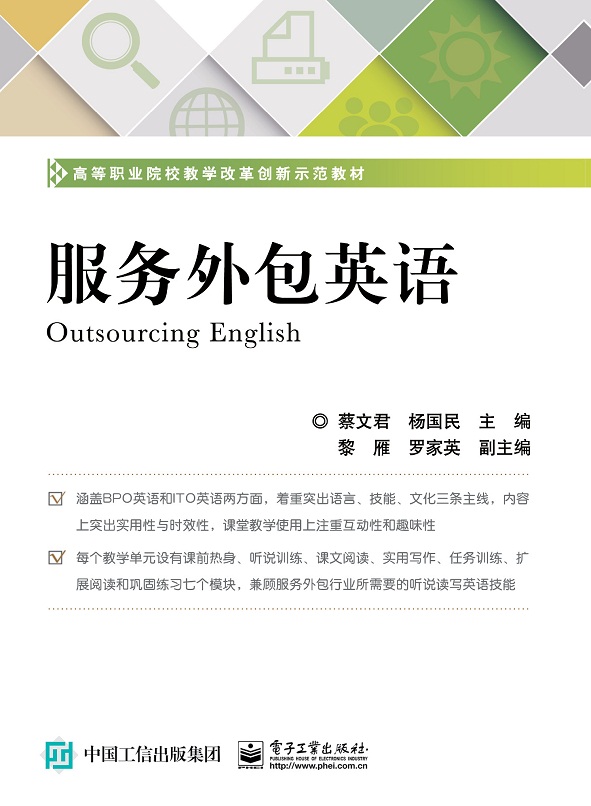会计英语 / 高职高专会计专业规划教材
¥32.00定价
作者: 李天宇,范明等
出版时间:2018-12
出版社:清华大学出版社
- 清华大学出版社
- 9787302500353
- 1-1
- 223191
- 64215622-8
- 平装
- 16开
- 2018-12
- 152
- 管理学
- 工商管理
- F23
- 会计、财务管理
- 高职
内容简介
《会计英语》是一本会计英语教材。全书共有九章,分别从知识概述、会计等式和复式记账、会计循环、流动资产、非流动资产、负债、所有者权益、财务报表及财务报表分析等方面展开介绍,每章集中介绍一个财务知识点,都有实例说明。各章自成体系,可以单独讲授。各章所研究的财务知识点联系起来构成完整的财务知识体系,全书是一个有机整体。《会计英语》简明通俗,是一本实用性较强的教学和自学用书,适合高职高专及在职人员在校学习,可用于财经院校、综合性大学在职继续教育和自学参考,也可供研究人员和实际工作者学习之用。
目录
目 录Chapter One The Introduction of Accounting 11.1 Introduction 31.2 The Users of Accounting Information 31.2.1 External Information Users 41.2.2 Internal Information Users 51.3 The Accounting Process 51.4 Basic Accounting Principles 61.4.1 Accrual Principle 61.4.2 Conservatism Principle 71.4.3 Consistency Principle 71.4.4 Cost Principle 71.4.5 Economic Entity Principle 71.4.6 Full Disclosure Principle 81.4.7 Going Concern Principle 81.4.8 Matching Principle 81.4.9 Materiality Principle 81.4.10 Monetary Unit Principle 81.4.11 Reliability Principle 91.4.12 Revenue Recognition Principle 91.4.13 Time Period Principle 91.5 Financial Statements 91.5.1 Balance Sheet 91.5.2 Income Statement 91.5.3 Cash Flow Statement 101.5.4 The Statement of Changes in Equity 10Words and Expressions 10Notes 12Supplementary Reading 12Chapter Two Accounting Equation and Double Entry Accounting 182.1 Introduction 192.2 Accounting Equation 202.3 Double Entry Accounting 212.3.1 Debits and Credits in Common Accounting Transactions 222.3.2 Examples of Double Entry Accounting 23Words and Expressions 25Notes 25Supplementary Reading 26Chapter Three Accounting Cycle 303.1 Introduction 323.2 Identify Transactions or Events to Be Recorded 323.3 Journalize Transactions and Events 323.4 Posting from Journal to Ledger 333.5 Prepare Unadjusted Trial Balance 333.6 Journalize and Post Adjusting Journal Entries 333.7 Prepare Adjusted Trial Balance 343.8 Prepare Financial Statements 343.9 Journalize and Post Closing Entries 353.10 Prepare Post-closing Trial Balance 35Words and Expressions 36Notes 36Supplementary Reading 37Chapter Four Current Assets 434.1 Introduction 454.2 Cash and Cash Equivalent 454.3 Receivable 464.3.1 Accounts Receivable 464.3.2 Notes Receivable 474.4 Allowance Method 474.5 Inventory 484.5.1 Periodic Inventory System 494.5.2 Perpetual Inventory System 494.5.3 Inventory Measurement 51Words and Expressions 53Notes 54Supplementary Reading 55Chapter Five Non-current Assets 625.1 Introduction 635.2 Plant Assets 645.2.1 Measuring the Cost of Long-term Assets 645.2.2 Depreciation 655.2.3 Changing the Salvage Value of Depreciable Assets 695.3 Intangible Assets 705.3.1 Goodwill 715.3.2 Patent 715.3.3 Trademark and Trade Name 725.3.4 Franchise 725.3.5 Copyright 72Words and Expressions 73Notes 73Supplementary Reading 74Chapter Six Liabilities 796.1 Introduction 816.2 Current Liabilities 816.2.1 Accounts Payable 816.2.2 Notes Payable 826.2.3 Accrued Expenses 836.2.4 Unearned Revenue 836.2.5 The Current Portion of Long-term Debt 836.2.6 Contingent Liabilities 846.3 Long-term Liabilities 856.3.1 Accrued Interest 856.3.2 Bonds Issued at Par with No Accrued Interest 866.3.3 Bonds Issued at Par with Accrued Interest 87Words and Expressions 89Notes 89Supplementary Reading 90Chapter Seven Owner’s Equity 957.1 Introduction 967.2 Stock 977.2.1 Common Stock 977.2.2 Preferred Stock 997.3 Shareholder’s Equity 1007.3.1 Paid-in Capital 1007.3.2 Retained Earnings 1017.4 Dividends 1027.4.1 Cash Dividends 1027.4.2 Stock Dividends 1037.4.3 Stock Split 105Words and Expressions 106Notes 106Supplementary Reading 107Chapter Eight Financial Statements 1118.1 Introduction 1128.2 Balance Sheet 1138.3 Income Statement 1158.3.1 The Multiple-step Income Statement 1158.3.2 The Single-step Income Statement 1178.4 Cash Flow Statement 1188.4.1 Definition of Cash 1188.4.2 Classification of Cash Flows 1198.4.3 Basic Approach to Preparation 120Words and Expressions 121Notes 122Supplementary Reading 123Chapter Nine Analysis of Financial Statements 1269.1 Introduction 1279.2 Four Widely Used Analytical Techniques 1289.2.1 Dollar and Percentage Changes 1289.2.2 Trend Percentages 1299.2.3 Component Percentages 1309.2.4 Ratios 1319.3 Limitations of Financial Ratio Analysis 138Words and Expressions 139Notes 140Supplementary Reading 140参考文献 144














